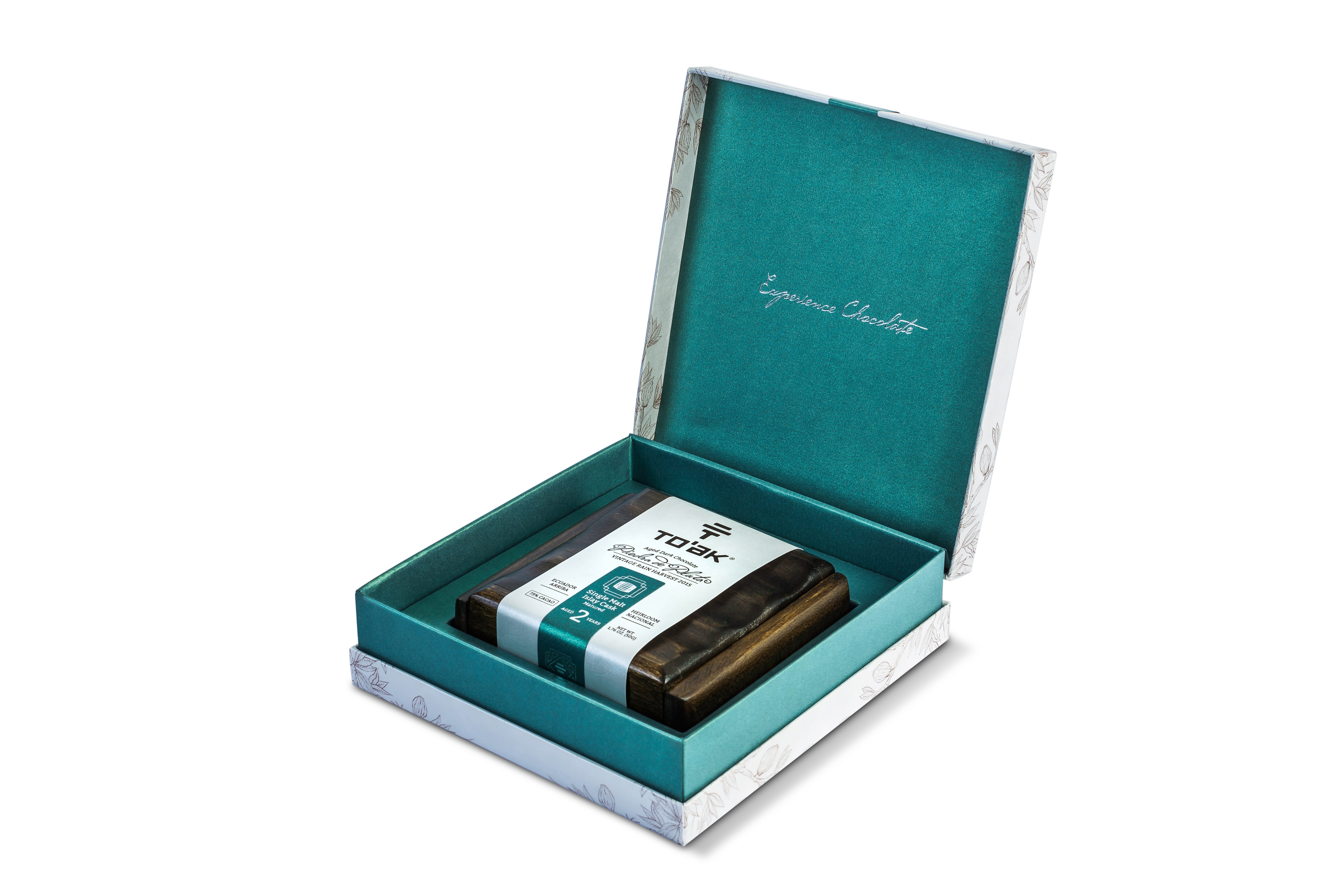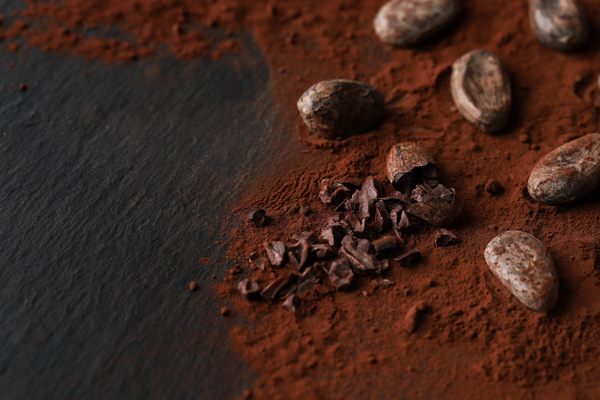How to Sell a $300 Chocolate Bar
Follow the wine playbook.

If you imagine an expensive bottle of wine, what comes to mind? You may have visions of a vineyard in France or a dusty cellar where centuries-old bottles are removed with care. Or perhaps you think of sloshing liquid poured in a rounded wine glass, where it is swirled, sniffed, and tasted. Whatever association comes to mind, most people would agree there’s no rush to consume an expensive wine.
That’s an idea the wine world wants to instill in customers. Learning tidbits about a wine’s place of origin—or holding it up to the light—are crucial to building up the prestige of a high-end product. It’s with this sense of ritual and backstory that Jerry Toth, co-founder of To’ak Chocolate, hopes to elevate a traditionally cheap, sweet treat into the luxury market, with chocolate bars starting at $295.
Several hundred dollars may seem like a lot to pay for one bar of chocolate. But according to Christopher Olivola, assistant professor of marketing at Carnegie Mellon University, a $295 price tag is also a selling point. Most customers believe that if something is expensive, it’s bound to be a better product (better ingredients; more attention to detail). In contrast, it’s impossible to convince someone that a one-dollar chocolate bar or five-dollar wine is the world’s best. This phenomenon is known as the price heuristic.
But a high price is not enough, of course. Selling a luxury product—including Toth’s To’ak chocolates—requires good storytelling.

When he presents his bars to customers, Toth describes the chocolate’s route from Ecuador to their hands. The story, which Toth printed in a 116-page booklet, begins with 5,300-year-old cocoa trees in Piedra de Plata, the valley in Ecuador where Toth sources the chocolate. He compares it to Bordeaux, France. The narrative then highlights 14 growers who hand-sort and shell the beans, which then go through no less than six phases of quality control.
“The more effort and time it takes to hand-make something,” says Olivola, “the more people are willing to add a value to it.” Olivola points to Starbucks’s conversion of coffee as a ho-hum beverage to artisanal commodity as one example of this effect, which is known in psychology as the effort heuristic.
This sense of attention to detail and romantic, traditional origins has helped sell Americans on four-dollar, artisanal toast. It also explains why Stella Artois is presented as a luxury good in the United States, even though it’s seen as an inferior product in its home country of Belgium.
Toth himself has a pretty good backstory. A graduate of Cornell University, he escaped the world of New York investment banking to explore Central and South America. He worked odd jobs for five years, until a job as foreign correspondent in Ecuador focused his attention on unsustainable development. He became convinced that politics wasn’t going to address those issues.
A year later, he co-founded Third Millennium Alliance, a rainforest conservation foundation, with an Ecuadorian sustainability expert and an American ecologist. They created the Jama-Coaque Ecological Reserve, and there, they discovered semi-wild cacao trees whose fruits the group began making into chocolate—inside a bamboo house the group built by hand. The homemade bars led to the creation of To’ak and a tangible product Toth could export to promote his mission of saving the rainforest.

Whether intentional or not, Toth leverages the effort heuristic when he discusses (and sells) the founding story of To’ak Chocolate. He doesn’t quote the price and walk away. He emphasizes the care put into each bar (weeks of work by hand). He provides historical background on cacao, which lets him weave in the message that his chocolate is rare. He keeps the storyline top of mind for customers who purchase To’ak by placing a single, roasted cacao bean in the center of each bar in altar-like fashion. And, of course, he holds tastings and educates people on how to appreciate and savor $300 bars of chocolate.
Similar to champagne and wine, To’ak Chocolate is meant to be smelled, savored, and meditated on. Toth’s team recommends a quiet, smell-free room. Ideally, tasters should open the packaging, breath in the bar’s aroma, and pick it up with a provided pair of tongs that prevent the melting of any precious material. From there, Toth suggests placing a square of chocolate into your mouth, breaking it into small pieces with your teeth, and letting it melt. No chewing.
Rituals like these are common among artisanal products, and almost anything can be pushed into this category, says Olivola. “Rituals bring people together. Throughout culture, people partake in fun or painful rituals. It makes them feel like they can control the outcome by taking part.”
If this all seems like a bit much—or not even to sell hundred-dollar chocolate—consider wine and wine tasting, which evolved from humble roots.

“The criteria for a good wine was [once] dramatically different than it is today,” says Kolleen Guy, associate professor of history at University of Texas at San Antonio. Initially, wine was judged using elements of Galenic medicine (hot, cold, wet, dry) to balance foods, and, into the 18th century, wine tasting meant a worker in a warehouse or cellar engaging in quality control. Poetic language such as green, cherry blossoms, and citrus only arose in the 19th century as the Industrial Revolution created a growing middle class and more emphasis on good taste.
Similarly, Rachel Speckan, an advanced sommelier, points out that the rise of wine as an intellectual pursuit only began in earnest in the 1970s. She cites the founding of the Wine & Spirits Education Trust at the time, as well as the first master sommelier examinations by the United Kingdom’s Court of Master Sommeliers. Both remain leading institutions. And while visiting a winery is now common, such intense interest in a wine’s origins and the viticulturists is relatively modern—a contrast to the traditional business-to-business nature of the wine industry.
Chocolate is arguably headed on the same path: While the industry was once mostly milk chocolate marketed to kids, it’s increasingly common for adults to buy expensive truffles and visit artisanal chocolate factories. To’ak just represents a (hopeful) leap into the future.
“The tasting procedure is something that has been around for a long time, and originated in the wine industry,” says Toth, who once aspired to become a sommelier and openly concedes to following the industry’s playbook. “[Chocolate tasting] might be a new concept, but we’re not re-inventing the wheel.”

But an important part of that playbook is authenticity, and the feeling that the stories and the process is not cynical. The success of To’ak Chocolate will likely be determined not by the effort heuristic and rituals, but by the sincerity of Toth and his team.
“What we’re trying to do is bring respect back to [the cacao bean], which was once so highly regarded that it was even used as currency by pre-Colombian civilizations in Latin America,” says Toth. “Theobroma, the Latin name given to cacao by early Spanish explorers, means ‘Food of the Gods.’”
Toth describes To’ak Chocolate as a way to educate the world about the rich history of cacao, to pay farmers the right price for their work, and to rescue chocolate from being relegated to a cheap, check-out impulse buy. And when you think of it that way, $300 seems like a small price to pay to help restore glory to Ecuador’s cacao tree.
Gastro Obscura covers the world’s most wondrous food and drink.
Sign up for our regular newsletter.
























Follow us on Twitter to get the latest on the world's hidden wonders.
Like us on Facebook to get the latest on the world's hidden wonders.
Follow us on Twitter Like us on Facebook